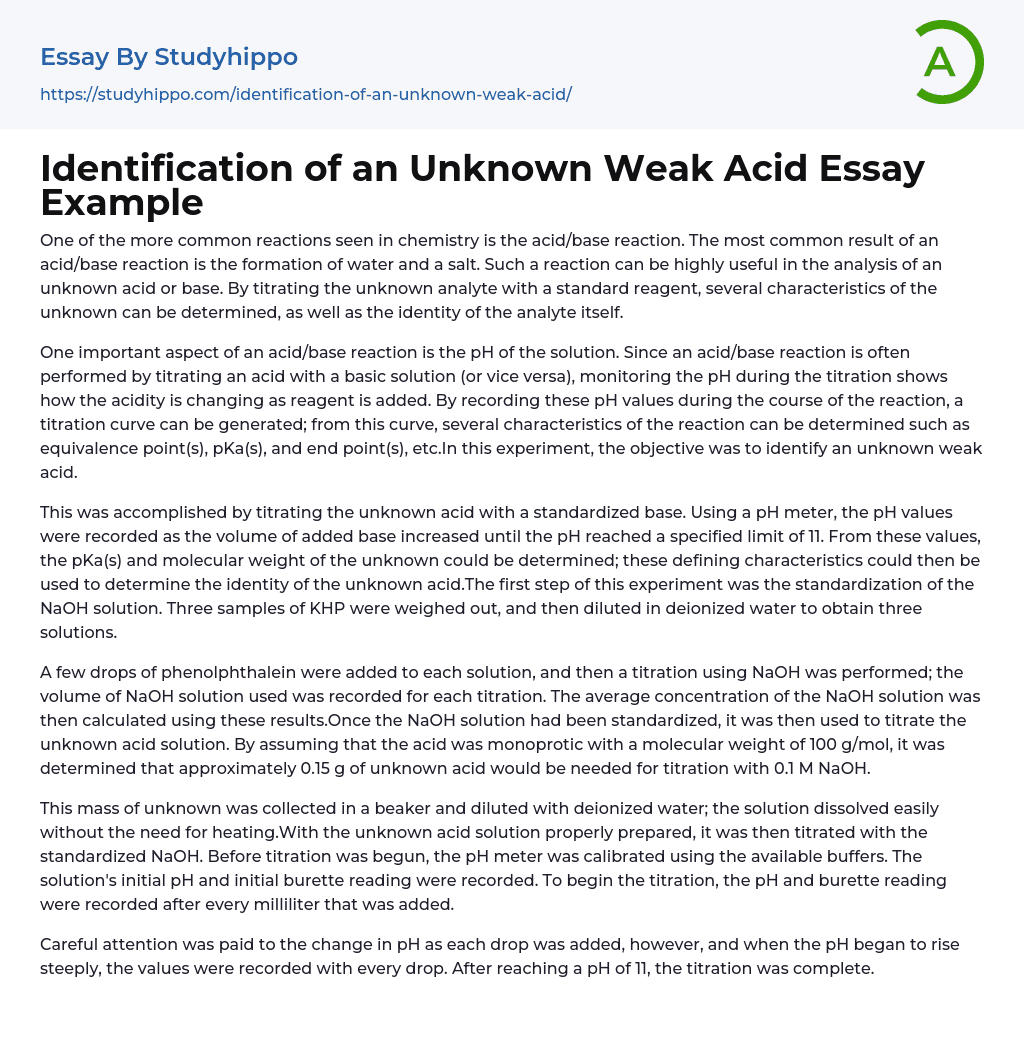One of the more common reactions seen in chemistry is the acid/base reaction. The most common result of an acid/base reaction is the formation of water and a salt. Such a reaction can be highly useful in the analysis of an unknown acid or base. By titrating the unknown analyte with a standard reagent, several characteristics of the unknown can be determined, as well as the identity of the analyte itself.
One important aspect of an acid/base reaction is the pH of the solution. Since an acid/base reaction is often performed by titrating an acid with a basic solution (or vice versa), monitoring the pH during the titration shows how the acidity is changing as reagent is added. By recording these pH values during the course of the reaction, a titration curve can be generated; from this curve, several characteristics of
...the reaction can be determined such as equivalence point(s), pKa(s), and end point(s), etc.In this experiment, the objective was to identify an unknown weak acid.
This was accomplished by titrating the unknown acid with a standardized base. Using a pH meter, the pH values were recorded as the volume of added base increased until the pH reached a specified limit of 11. From these values, the pKa(s) and molecular weight of the unknown could be determined; these defining characteristics could then be used to determine the identity of the unknown acid.The first step of this experiment was the standardization of the NaOH solution. Three samples of KHP were weighed out, and then diluted in deionized water to obtain three solutions.
A few drops of phenolphthalein were added to each solution, and then a titration usin
NaOH was performed; the volume of NaOH solution used was recorded for each titration. The average concentration of the NaOH solution was then calculated using these results.Once the NaOH solution had been standardized, it was then used to titrate the unknown acid solution. By assuming that the acid was monoprotic with a molecular weight of 100 g/mol, it was determined that approximately 0.15 g of unknown acid would be needed for titration with 0.1 M NaOH.
This mass of unknown was collected in a beaker and diluted with deionized water; the solution dissolved easily without the need for heating.With the unknown acid solution properly prepared, it was then titrated with the standardized NaOH. Before titration was begun, the pH meter was calibrated using the available buffers. The solution's initial pH and initial burette reading were recorded. To begin the titration, the pH and burette reading were recorded after every milliliter that was added.
Careful attention was paid to the change in pH as each drop was added, however, and when the pH began to rise steeply, the values were recorded with every drop. After reaching a pH of 11, the titration was complete.
- Acid Rain essays
- Acid essays
- Calcium essays
- Carbohydrate essays
- Carbon essays
- Chemical Bond essays
- Chemical Reaction essays
- Chemical reactions essays
- Chromatography essays
- Concentration essays
- Copper essays
- Diffusion essays
- Ethanol essays
- Hydrogen essays
- Organic Chemistry essays
- Osmosis essays
- Periodic Table essays
- Ph essays
- Salt essays
- Sodium essays
- Titration essays




